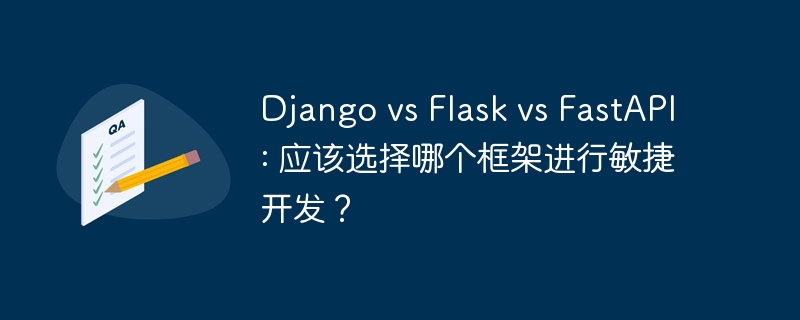
Django vs Flask vs FastAPI: Which framework should you choose for agile development?
Introduction:
When doing agile development, choosing an appropriate framework is crucial. Django, Flask, and FastAPI are among the most popular web frameworks in the Python language. This article will compare these three frameworks from the perspectives of development efficiency, flexibility, performance and community support, and give some specific code examples to help readers better understand.
1. Development efficiency comparison
- Django:
Django is a powerful and comprehensive framework with many built-in modules and functions. It provides many convenient functions, such as ORM, template engine, user authentication, etc. This enables you to build complex applications quickly. However, due to its many built-in features, it may require more learning time when you first start using it.
- Flask:
Flask is a flexible and concise framework that provides basic functionality and allows you to choose appropriate plug-ins to extend your application. Compared with Django, Flask has a gentler learning curve and is more suitable for small projects and rapid prototype development. However, for some advanced features, you may need corresponding plugins to extend Flask's capabilities.
- FastAPI:
FastAPI is the latest Python framework, which provides a very high-performance development method. It uses new features in Python 3.7 such as type hints and asynchronous request handling. FastAPI aims to provide the simplicity of Flask and the feature richness of Django. Due to its strong performance, FastAPI performs well when handling high concurrent requests. However, FastAPI is relatively new and its community and plugin ecosystem are relatively small.
2. Comparison of flexibility
- Django:
The design goal of Django is to build large, complex applications. It provides a wealth of built-in functions and modules, allowing you to quickly build fully functional applications. However, the variety and complexity of built-in features can sometimes limit your flexibility.
- Flask:
Flask is a very flexible framework that allows you to customize it according to your project needs. You can choose the right plugins and extensions according to your needs. Flask's design concept is "simple but not lacking in functionality", which makes it widely used in small projects and rapid prototyping development.
- FastAPI:
FastAPI provides Flask-like simplicity and Django-like functionality. It combines the advantages of both and uses new features such as asynchronous request processing and type hints to make development more efficient. At the same time, FastAPI also provides a powerful dependency injection system, allowing you to easily manage the components of your application.
3. Performance comparison
- Django:
Since Django provides many built-in functions and modules, this may have a certain impact on performance. Especially when handling high concurrent requests, Django's performance may be relatively low.
- Flask:
Flask has better performance than Django. Due to its streamlined design and flexible structure, Flask performs well when handling high concurrent requests.
- FastAPI:
FastAPI is a high-performance framework that achieves extremely high performance by using asynchronous request handling, type hints, and Pydantic-based data validation. The performance of FastAPI is comparable to other high-performance frameworks such as Node.js and Go.
4. Comparison of community support
- Django:
Django is a very mature and popular framework with a large community and active contributors. This means you can easily find the documentation, tutorials, and solutions you need. At the same time, Django’s plug-ins and extensions are also very rich to meet the needs of different projects.
- Flask:
Flask also has a huge community and rich resources. Thanks to its clean and flexible design, you can find a large number of plugins and libraries to accomplish specific tasks. Flask's community of contributors is also very active, and there are many excellent projects and solutions to choose from.
- FastAPI:
FastAPI is a relatively new framework, so its community and plugin ecosystem are relatively small. However, FastAPI is developing rapidly and the community is growing rapidly. You can get support and help by reading official documentation and participating in community discussions.
To summarize, which framework to choose depends on your project’s needs and preferences. If you need to build large, feature-rich applications, Django may be a good choice. If you need a more flexible framework, you can choose Flask for custom development. For projects that pursue ultimate performance and high concurrency processing, FastAPI may be a more ideal choice.
Code example (taking Flask as an example):
from flask import Flask
app = Flask(__name__)
@app.route('/')
def hello():
return "Hello, World!"
if __name__ == '__main__':
app.run()Copy after login
The above is a simple example written using the Flask framework. With this example, you can see the simplicity and flexibility of the Flask framework. You can build a simple web application with just a few lines of code.
Conclusion:
When doing agile development, it is very important to choose an appropriate framework. This article compares the three Python frameworks of Django, Flask and FastAPI from the perspectives of development efficiency, flexibility, performance and community support. Through comparison and explanation of code examples, we hope to help readers better understand the characteristics and applicable scenarios of these frameworks, and make wise choices. But the final choice should be decided based on project needs and personal preference.
The above is the detailed content of Django vs Flask vs FastAPI: Which framework should you choose for agile development?. For more information, please follow other related articles on the PHP Chinese website!

